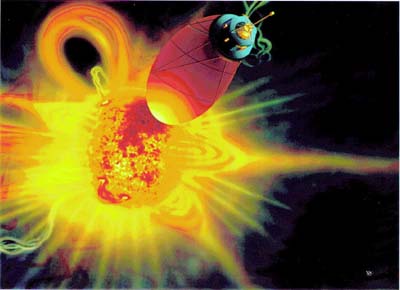

|
These web pages collect some of the material from that report and put it together with material of my own. The final report can be seen at http://outerplanets.LaRC.NASA.gov/outerplanets. This is purely an informal compilation
reflecting
my interests and was done independently
- Steve Suess -
|
|
 |
 |
SynopsisIt is time to move beyond vicariously studying the Sun and the Sun's atmosphere by collecting photons emitted by the plasma. It is time to take the next step and actually perform the in situ measurements from a spacecraft flying through the corona - the Solar Probe. Solar Probe will be a mission of exploration and
discovery. It
is planned to fly from pole to pole to within 3 Rs from the
solar surface. It will sample the solar wind in the acceleration region
and will take high resolution images of the solar atmosphere and the
polar
regions of the surface. This will enable linking the wealth of
existing
remote observations to the actual physical state and dynamics of the
solar
corona. By the design of the mission, Solar Probe will fly
directly
through regions producing fast and slow wind which fills the solar
system,
modulates penetrating galactic cosmic rays and, and controls
interplanetary
space from the Sun to the local interstellar medium beyond the most
distant
planets.
|
Polar Wind and the Corona - the Context for Solar ProbeJust click on the item to go to that section of the Overview Summary. |
Current Scientific Understanding and QuestionsClick on the item to view the information
|
|
3 June 1999 |